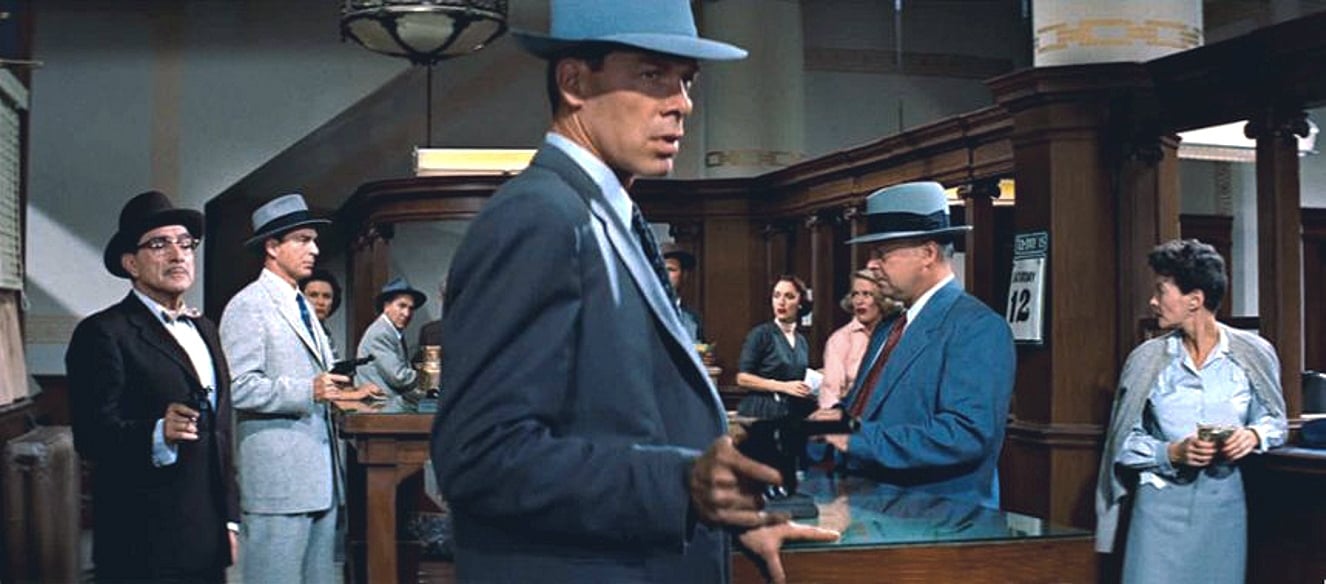
CinemaScope Photographic Techniques
Charles G. Clarke, ASC explains the advantages of CinemaScope to traditional filming methods.

By Charles G. Clarke, ASC
Editor's Note: Clarke, who is one of Twentieth Century-Fox’s top directors of photography, has perhaps photographed more film using the CinemaScope process than any other cinematographer in the industry. His knowledge of and experiences with the popular widescreen medium is set down here for the benefit of other cinematographers. The text with illustrations also is being published in booklet form by Twentieth Century-Fox Studios.
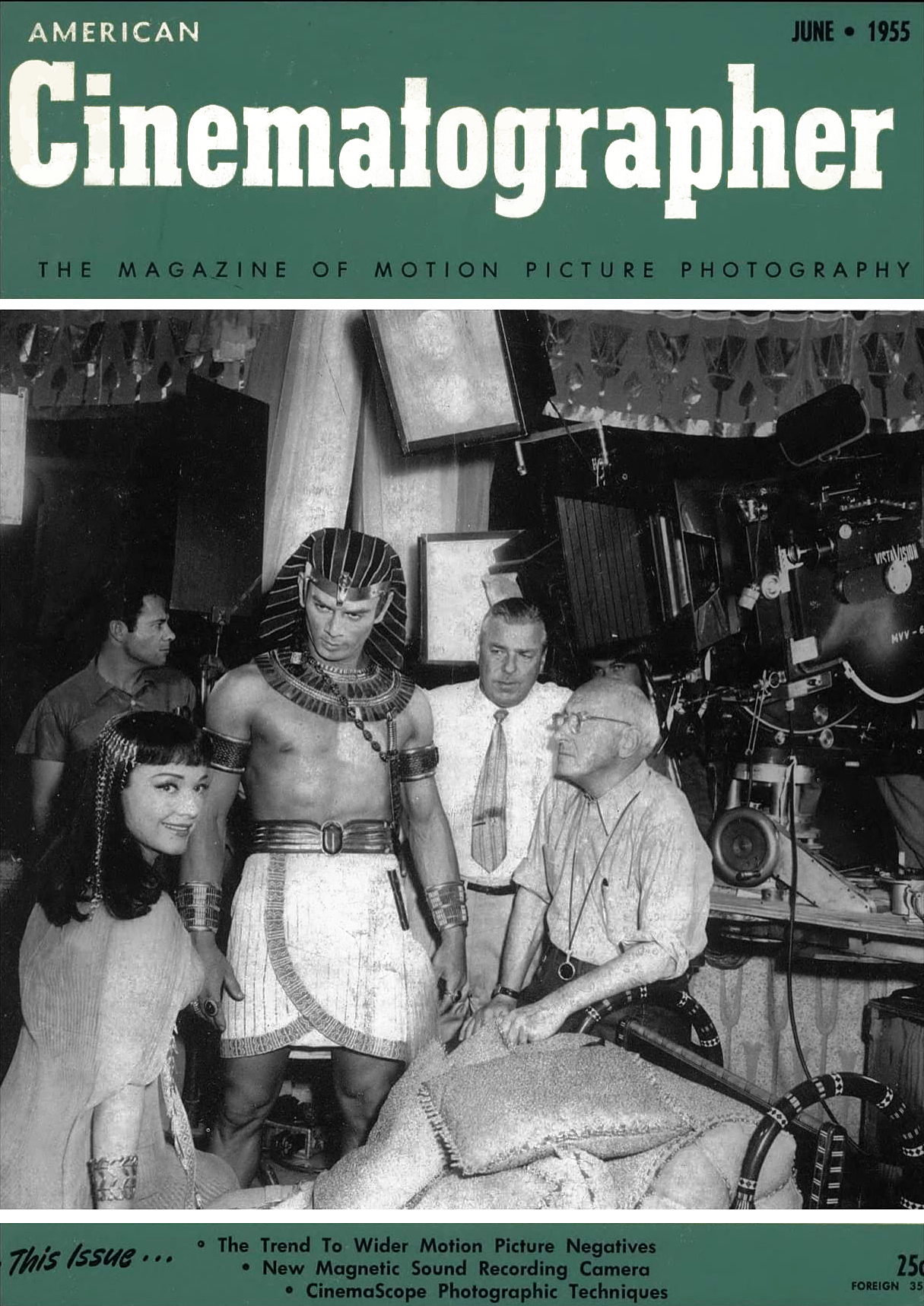
Whenever any new technique is introduced, it is frequently human reaction to view it with a certain amount of reservation and doubt. Probably this is the result of our becoming so accustomed to the previous and older methods that we approach new concepts hesitatingly. The CinemaScope technique of making motion pictures with stereophonic sound has met, to a limited degree, this reluctance to accept new ideas. I know this from experience, because in the course of filming CinemaScope during the past two years, here and in Europe, I have been asked many questions which indicate to me that the questioner is thinking in terms of applying the older technique to the newer medium. Also, many inquiries resulted from the usual host of misconceptions, misunderstandings and false information which invariably surround new and challenging developments.
In my talks with producers, I gather that many feel that the CinemaScope method is more expensive to use on production. More than one hundred films have now been made in this medium and it has been established that production costs are no greater, and in most cases less, than if the picture had been made in the older methods.
CinemaScope provides a presentation which simulates the wide angle experience of human vision and because of this most scenes can be staged with fewer cuts and camera angles than were formerly necessary. This is a big economic saving because the additional angles required by the older technique were time-consuming, and as a result, costly to make.
Another misconception is that the size of the sets for CinemaScope productions must be larger. Perhaps I can point out why. With CinemaScope, sets usually call for less construction, but to explain this I had better start at the beginning and first explain the CinemaScope optical system.
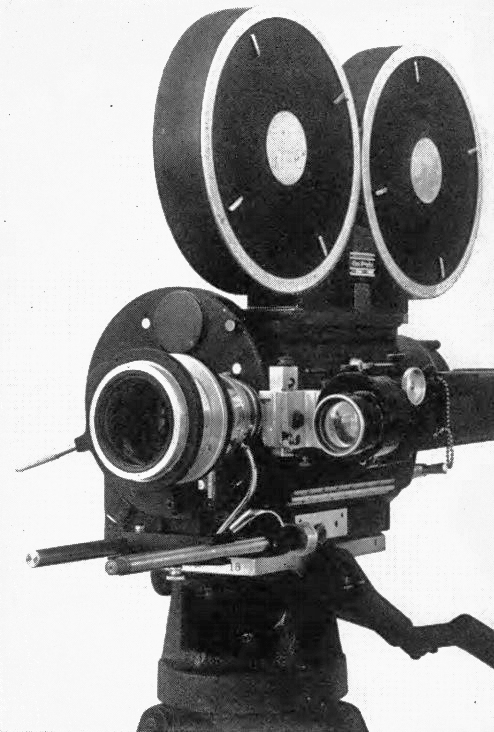
“attachment” lens above was an anamorphic unit
placed in front of the regular camera lens.
As most readers know, the Bausch & Lomb CinemaScope attachment lens itself is an optical unit that fits in front of any ordinary motion picture camera lens. (See Figure 2) It follows that it can be used with any 35mm camera and with many of the lenses that are normally used with that camera. What the CinemaScope attachment actually does is to take in an angle of vision, horizontally, two times that which the camera lens does without the attachment; the vertical angle of view is not changed. The picture seen by the lens combination is photographed in the camera through an aperture 23.8mm by 18.67mm in size.
When this attachment is used, for example, on a 50mm lens, the height of view remains the same but the width of view is similar to that obtained had a 25mm lens been used. The combination of the CinemaScope attachment on the camera, the camera aperture, the projector CinemaScope attachment and the projector CinemaScope aperture results in a picture on the screen which is approximately 2½ times as wide as it is high. These same proportions follow with any of the other photographic lenses.
Although the principle is the same, our newer lenses combine the functions of the conventional camera lens and the CinemaScope attachment in one housing and the complete arrangement has been designed as one optical system for optimum performance. Such a lens, mounted on a camera, is illustrated in Figure 3. Figure 1 shows the various Bausch & Lomb CinemaScope lenses now available. There are the 35mm, 40mm, 50mm, 75mm, and 100mm. In addition, there recently became available a 152mm lens, which is particularly suitable for background projection plate photography.
In normal practice the usual lenses used are the 40mm and 50mm, and other lenses are used for the same reasons that they are employed in regular photographic practice — the longer lenses being used for closeups, telephoto effects and the like. With this understanding of the lenses, and the following examples, it will be clear that sets need not be built as high nor any wider than formerly.
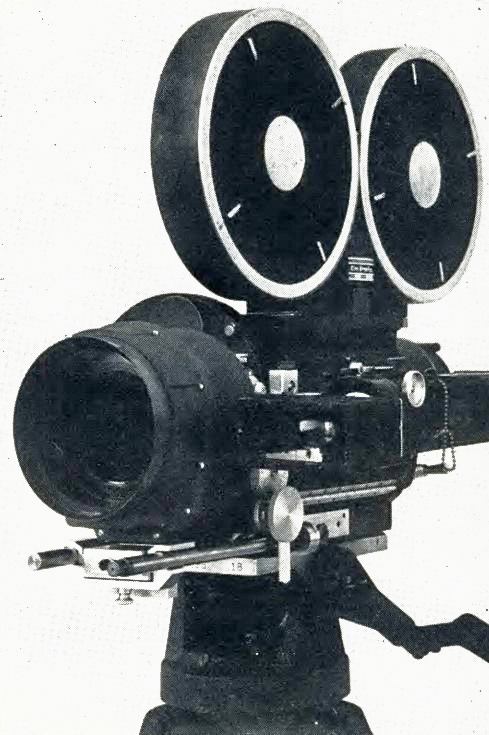
CinemaScope lens mounted on a 35mm motion
picture camera. It combines in one unit the regular camera lens plus the anamorphic lens system necessary to CinemaScope widescreen photography.
For instance, let us imagine that we want to photograph a small office set. With the older method we would have probably used a 25mm lens in order to keep within the walls. Suppose the action required a person to enter from a door in the foreground and go toward the rear and sit down at a desk. With the old technique, a ceiling piece would probably have been required to back up the person when in the foreground, and the camera would pan to hold on the desk.
The same scene when filmed in CinemaScope, although photographed from approximately the same set-up with a 50mm lens, would not require the ceiling, as the vertical angle of the scene is now less; however, the horizontal angle is the same as before. Rather than pan the camera to hold the character center, we would likely stay fixed and take advantage of stereophonic sound recording to enhance the actor movement as the sound moved with him in a natural way. Furthermore, the size of the figure in the rear of the set would not be so diminished because of the perspective drawing of the 50mm lens used as compared to the 25mm lens in the older method, therefore making it unnecessary to shoot a closeup angle. If it were the intention in the scene to get closer to the person at the desk, we could dolly in a little. There would be no distortion nor would the camera have to go in as close — also because of using the 50mm lens. Thus, we have an example of what happens in regular picture making — less construction is necessary, an extra set-up is unnecessary, stereophonic sound has been used, and above all, a commonplace scene is fresh and new because of the different treatment. Had this same scene been done in a natural interior, it can be understood why the necessary lights could have been more readily used because less of the ceiling area is included.
Naturally, one of the questions is, “How do you make a scene in a telephone booth?” By this time, the situation has been amply demonstrated in several films, especially Night People, and the same logic applies as in the foregoing example except that it is no longer necessary for the actor to crowd in on top of the mouthpiece in order to hold him in the picture.
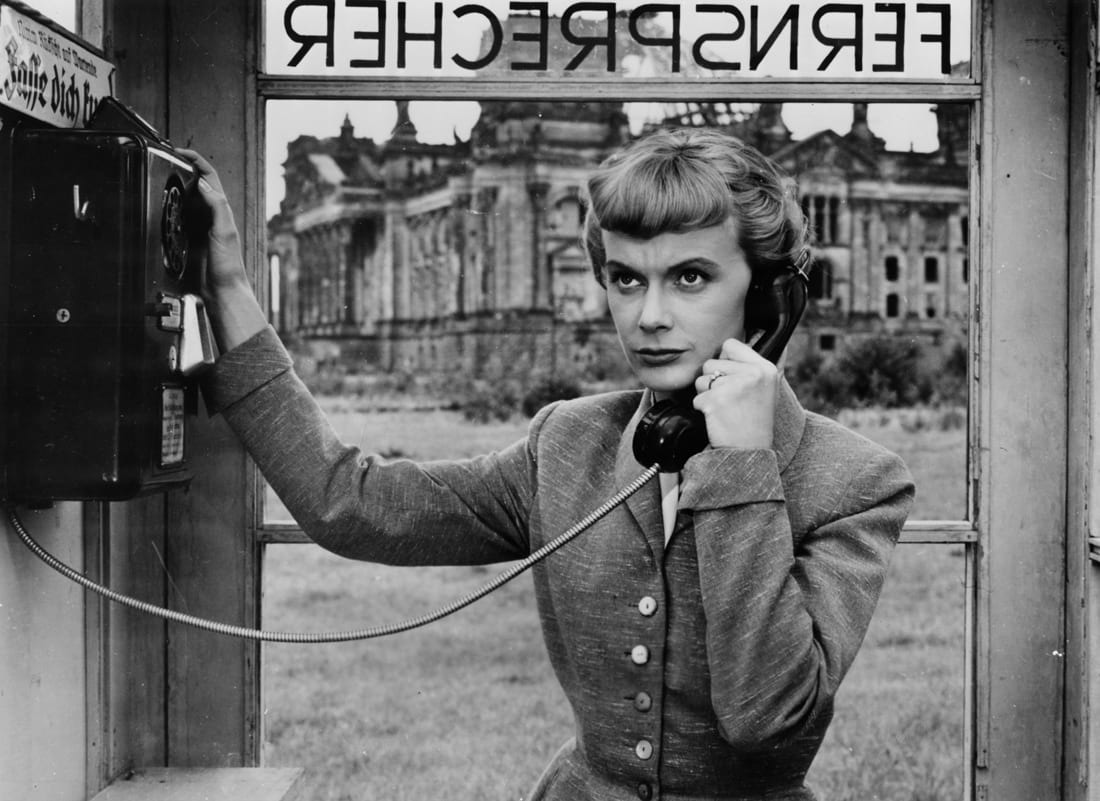
This leads us to the question of the “Closeup.”
The closeup is actually a relic of the silent era. It was necessary in those days to show facial expression, because the screen was small and there was no dialogue to convey what the scene was about. The closeup was carried over into sound films and is still useful for dramatic effects. In CinemaScope it is still used; however, because of the vastness of the theater screen, the huge “choker” closeups are no longer necessary. In fact, the figure size of the “two-shot” is larger on the modern screen than was the “big head” on the older, smaller screen. I personally prefer to use the “over-shoulder” shot when closeups are required. This is possible about ninety percent of the time and it certainly lends itself to far more interesting composition plus effective use of Stereophonic sound. With CinemaScope there is still freedom of expression and selectivity — no rigid rules exist.
It has been my experience that when the Director rehearses a sequence, allowing the actors to make moves that seem natural, and devising action to keep the scene interesting, there is no great problem in adapting the camera to the scene so rehearsed. I believe the camera should be fitted to the action and not the reverse as is so frequently done. After all, we are telling a story and the audience should never be aware of the techniques involved. After the geography of the set has been established, which is frequently done by the characters entering the scene in a long shot, I like to move in to a medium shot which covers the action. Now if the action is so staged that the characters are maneuvered to positions where the person having the most important dialogue is in an advantageous camera position, the camera can move forward or back and pan when necessary with the action as long as it is desirable to hold the scene.
I believe that it is more comfortable, interesting and natural to the spectator if scenes are sustained and a minimum number of cuts are made. A vast screen area approaching the periphery of vision requires new adjustment of the eyes each time the scene is changed. The wise director will stage his scenes to best use the advantages of this new technique. These advantages are great, for no longer must we confine the actors to areas forward and backward from the camera, but may now also use lateral movement. Spreading out of the action is what is done in stage productions, and indeed CinemaScope technique is like that of the theater with the added advantage of being able to move in with the camera to accentuate the most important portions of a scene. Speaking of moving the camera, all of the established methods of motivating the camera — cranes, dollies, etc. — can be utilized provided the handling is smooth, because any unsteadiness becomes exaggerated on the wide screen.
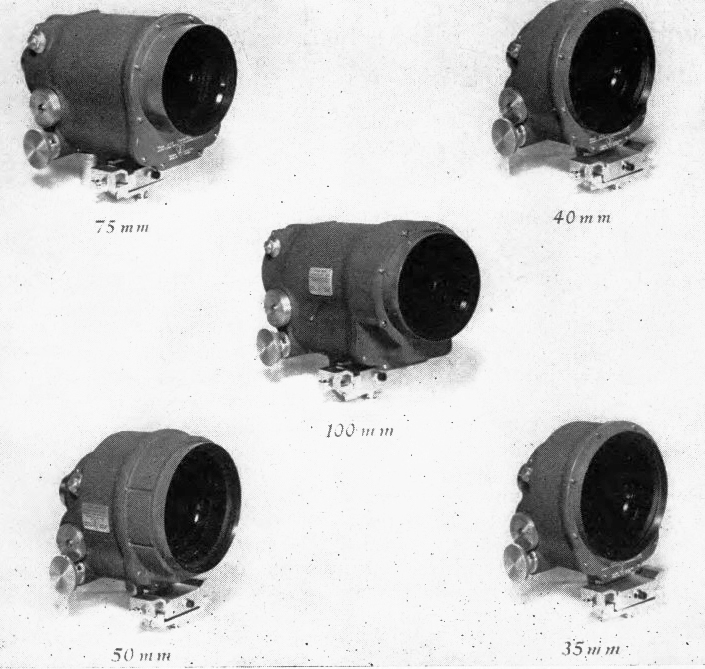
bination single-unit lenses pictured below. There are five of them: a 35mm, 40mm, 50mm,
75mm, 100mm, and a 152mm not pictured. The 40mm and the 50mm lenses are the
most widely used.
As scenes are more interesting when the players are in different planes of depth, the usual problem of depth of field is posed. I have found that a practical solution is to work at a one-thousand-foot candle key for interior day scenes. This permits a lens stop of f/4.5 which is sufficient to carry quite extreme ranges of focus.
All wide screen methods using 35mm release film require critical attention to the details which affect sharpness. This is mostly a matter of film resolution, but anything we can do to maintain maximum sharpness in the camera is on the credit side. Scenes of high contrast usually appear sharper, when projected, than those of a flatter nature, and it is fortunate that modern color films can be lighted with relatively high contrast. With former color films, we had to use a great amount of fill light to prevent the shadow side of the faces from reproducing with an objectionable reddish hue. Modern color films have the ability to preserve shadow detail without color distortion, so we may now use less fill light to obtain more interesting lightings and also enhance picture definition. Night interiors now appear as they should and, with the small amount of fill light needed, the lighting level is not unreasonable for comfort nor in the amount of equipment used.
On large sets, the 10K lamp is the most practical unit, while on smaller sets, the 5K and 2K are the lamps used at the light levels suggested above. Obviously, the f/4.5 stop is not inflexible. Many natural interiors cannot be lighted at 1,000 foot candles and it is not necessary unless there is a desire to extend depth of field. With natural interiors, photoflood lamps and the smaller incandescent units are successfully used.
The CinemaScope picture shape, as previously described, was chosen because it approximates the angle of vision of the human eye. Therefore, the spectator becomes a participant of each scene. With this fact in mind, it is good showmanship to devise as many camera angles as possible for “audience participation.” Low camera set-ups, views taken straight ahead from moving vehicles, etc., all create audience stimulation that lends excitement and enjoyment to the production. They should be used whenever logically possible.
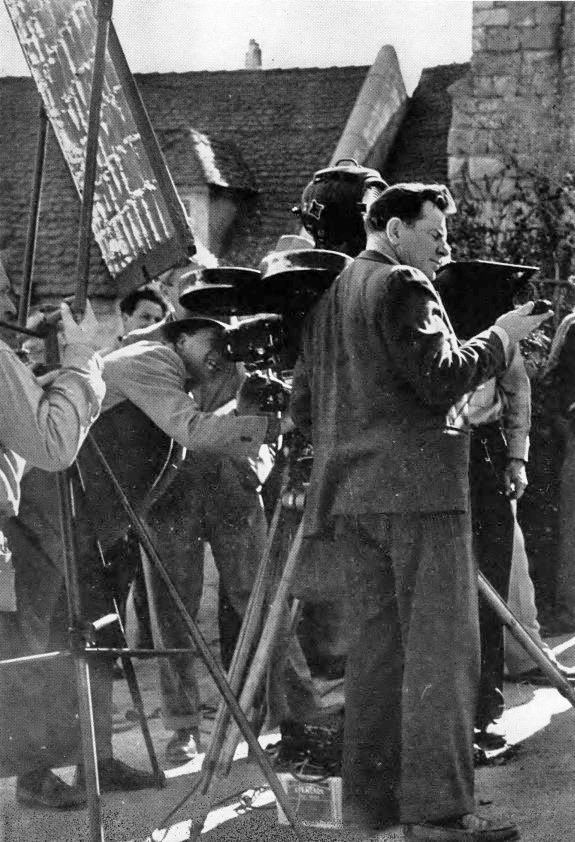
Rear projection scenes are easily accomplished and some, such as automobile interior scenes, are enhanced in CinemaScope. Where formerly we could only see through the rear window, now we can also include the side windows, thus obtaining greater reality and a better conception of the speed of the vehicle. Those scenes which include the driver are a natural composition for CinemaScope. In cases where the background screen has to be larger than is possible with rear projection, the “traveling matte” method is used. In the former case, the plates are made without the CinemaScope lens.
One of the contributing assets of the CinemaScope system is stereophonic sound. This has done much to add a new quality of reality to the screen, and is capable of further imaginative treatment to realize its fullest possibilities. The public has come to recognize the improvement in sound quality and naturalness and there is considerable evidence that it likes the new effect created by the surround loudspeakers. The seven or eight major producers releasing stereophonic magnetic prints in CinemaScope have taken cognizance of the public’s wishes and are making greater use of the surround effects in recent pictures. The use of stereophonic sound does not create any hardship in production.
In studio practice, three small microphones are spaced laterally at the end of the usual sound boom. The spacing is varied according to the nature of the scene and the microphone positions are easily manipulated as required by camera movement or to maintain intelligibility. Sensible effort is always applied to get original stereophonic recordings. When this is impossible or impractical, stereophonic post-dubbing is used to replace the dialogue of scenes which are good for picture but unacceptable for sound.
Theater attendance has been greatly stimulated by the advent of CinemaScope, and the producer has the opportunity now to present his stories in a fresh and exciting medium through this modern technique.







